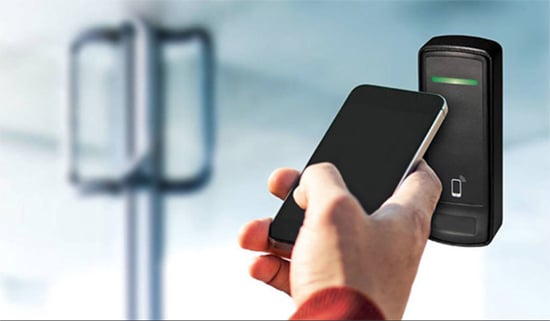Looking to the Future of Access Control
/ in 2019 /By Eva Mach
When we think of access control, the first thing that comes to mind for most is a badge that gives entry to authorized individuals. There is, of course, technology behind it, but compared to the rest of the industry it may seem that access control is lacking as far as innovation and new solutions go. However, what many do not realize are the growing number of solutions now available to end users, and wireless access and mobile credentials are part of this evolution.
The widespread development and increasing adoption of wireless access and mobile credentials have opened the door to future development. Looking more deeply, there is far more innovation happening that goes beyond a door simply opening. For example, Apple is running a prototype using Apple Pay and iPhones on college campuses. By connecting user’s phones to access control portals, there is a possibility to integrate the access control system with other systems. In this case, your wallet.
Access control options that are being adopted more widely on campuses include wireless locks. Wireless locks are replacing legacy locks, in turn allowing multiple wireless enabled devices and locks to communicate between each other. Criteria and conditions can be set, such as doors only being accessible to certain students on a college campus during certain times of day (i.e. class times). With editable criteria like this, security professionals on a campus or any other sector can ensure only the right people will have access to areas at the right time, including vendors making a delivery to an office or second shift employees for a warehouse.
While wireless connections make things easier and more controllable, there is concern involving the cyber security of these systems. Many end users in high security areas opt for multi-factor authentication rather than just knowledge of a pin or presenting a badge to enter a premise. A pin might be the first level of security, but a more advanced access control system could also require users to present an access control credential, including biometrics. The beauty of the innovation in access control is that it can be as simple or as complex as the user requires.
Overall, by opting for a wireless access control system, end users are given more flexibility, data backup and risk mitigation. There has not been a lot of new areas in access control for many years, but that has begun to change with the introduction of managed services with a cyber security emphasis along with blue tooth enabled devices that provide a better user experience more secure environment and ease of use for the security personnel.
This, along with increasing adoption of wireless and mobile credentials, is giving the industry an opportunity to bring access control to the forefront when talking about risk management. In addition, the deployment of sensors and analytics will allow the end users to gather information about comfort level within a building resulting in better customer experience and cost savings through adjusting the use of power.






